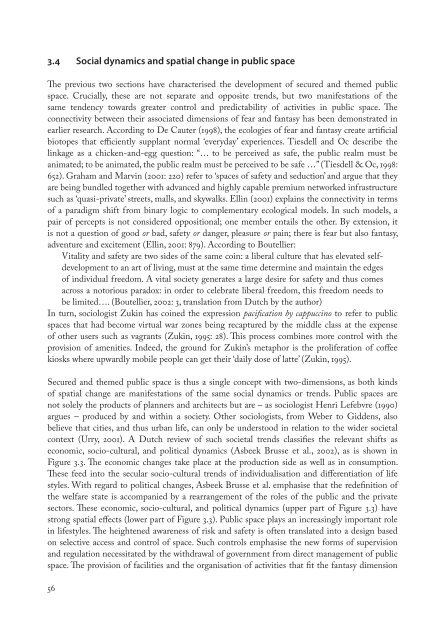Changing public space
Changing public space
Changing public space
You also want an ePaper? Increase the reach of your titles
YUMPU automatically turns print PDFs into web optimized ePapers that Google loves.
3.4 Social dynamics and spatial change in <strong>public</strong> <strong>space</strong><br />
The previous two sections have characterised the development of secured and themed <strong>public</strong><br />
<strong>space</strong>. Crucially, these are not separate and opposite trends, but two manifestations of the<br />
same tendency towards greater control and predictability of activities in <strong>public</strong> <strong>space</strong>. The<br />
connectivity between their associated dimensions of fear and fantasy has been demonstrated in<br />
earlier research. According to De Cauter (1998), the ecologies of fear and fantasy create artificial<br />
biotopes that efficiently supplant normal ‘everyday’ experiences. Tiesdell and Oc describe the<br />
linkage as a chicken-and-egg question: “… to be perceived as safe, the <strong>public</strong> realm must be<br />
animated; to be animated, the <strong>public</strong> realm must be perceived to be safe …” (Tiesdell & Oc, 1998:<br />
652). Graham and Marvin (2001: 220) refer to ‘<strong>space</strong>s of safety and seduction’ and argue that they<br />
are being bundled together with advanced and highly capable premium networked infrastructure<br />
such as ‘quasi-private’ streets, malls, and skywalks. Ellin (2001) explains the connectivity in terms<br />
of a paradigm shift from binary logic to complementary ecological models. In such models, a<br />
pair of percepts is not considered oppositional; one member entails the other. By extension, it<br />
is not a question of good or bad, safety or danger, pleasure or pain; there is fear but also fantasy,<br />
adventure and excitement (Ellin, 2001: 879). According to Boutellier:<br />
Vitality and safety are two sides of the same coin: a liberal culture that has elevated selfdevelopment<br />
to an art of living, must at the same time determine and maintain the edges<br />
of individual freedom. A vital society generates a large desire for safety and thus comes<br />
across a notorious paradox: in order to celebrate liberal freedom, this freedom needs to<br />
be limited…. (Boutellier, 2002: 3, translation from Dutch by the author)<br />
In turn, sociologist Zukin has coined the expression pacification by cappuccino to refer to <strong>public</strong><br />
<strong>space</strong>s that had become virtual war zones being recaptured by the middle class at the expense<br />
of other users such as vagrants (Zukin, 1995: 28). This process combines more control with the<br />
provision of amenities. Indeed, the ground for Zukin’s metaphor is the proliferation of coffee<br />
kiosks where upwardly mobile people can get their ‘daily dose of latte’ (Zukin, 1995).<br />
Secured and themed <strong>public</strong> <strong>space</strong> is thus a single concept with two-dimensions, as both kinds<br />
of spatial change are manifestations of the same social dynamics or trends. Public <strong>space</strong>s are<br />
not solely the products of planners and architects but are – as sociologist Henri Lefebvre (1990)<br />
argues – produced by and within a society. Other sociologists, from Weber to Giddens, also<br />
believe that cities, and thus urban life, can only be understood in relation to the wider societal<br />
context (Urry, 2001). A Dutch review of such societal trends classifies the relevant shifts as<br />
economic, socio-cultural, and political dynamics (Asbeek Brusse et al., 2002), as is shown in<br />
Figure 3.3. The economic changes take place at the production side as well as in consumption.<br />
These feed into the secular socio-cultural trends of individualisation and differentiation of life<br />
styles. With regard to political changes, Asbeek Brusse et al. emphasise that the redefinition of<br />
the welfare state is accompanied by a rearrangement of the roles of the <strong>public</strong> and the private<br />
sectors. These economic, socio-cultural, and political dynamics (upper part of Figure 3.3) have<br />
strong spatial effects (lower part of Figure 3.3). Public <strong>space</strong> plays an increasingly important role<br />
in lifestyles. The heightened awareness of risk and safety is often translated into a design based<br />
on selective access and control of <strong>space</strong>. Such controls emphasise the new forms of supervision<br />
and regulation necessitated by the withdrawal of government from direct management of <strong>public</strong><br />
<strong>space</strong>. The provision of facilities and the organisation of activities that fit the fantasy dimension<br />
56




